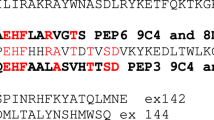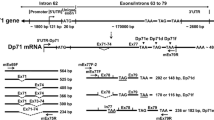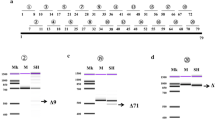Abstract
Because numerous diseases affect the muscle and nervous systems, it is important to identify and characterize genes that may play functional roles in these tissues. Sequence analysis of a 106-kb region of human Chromosome (Chr) 19ql3.2 revealed a novel gene with homology to the Neuroendocrine-specific protein (NSP), and it has, therefore, been designated NSP-like 1 (Nspl1). We isolated the mouse homolog of this gene and performed extensive expression analysis of both the mouse and human genes. The mouse Nspl1 gene is alternatively spliced to produce two major transcripts: a 2.1-kb mRNA that is expressed at highest levels in the brain, and a 1.2-kb transcript that is primarily expressed in muscle. The larger message contains 10 exons, whereas the smaller transcript contains 7 exons. The last 6 exons, which are present in both transcripts, share significant amino acid sequence identity with the endoplasmic reticulum-bound portion of NSP. Mouse and human Nspl1/NSPL1 genes have expression patterns that are similar to that of the dystrophin gene. In addition, the putative regulatory domains of Nspl1 appear similar in composition and distribution to the defined dystrophin regulatory sequences.
Similar content being viewed by others
References
Altschul S, Gish W, Miller W, Myers E, Lipman D (1990) Basic local alignment search tool. J Mol Biol 215, 403–410
Andres V, Cervera M, Mahdavi V (1995) Determination of the consensus binding site for MEF2 expressed in muscle and brain reveals tissue-specific sequence constraints. J Biol Chem 270, 23246–23249
Anh A, Kunkel L (1993) The structure and functional diversity of dystrophin. Nat Genet 3, 283–291
Ausubel FM (1994) Current Protocols in Molecular Biology, Volume 1. (New York: John Wiley & Sons, Inc.) Unit 4.5.1 to 4.5.3
Bairoch A, Boeckmann B (1993) The SWISS-PROT protein sequence data bank, recent developments. Nucleic Acids Res 21, 3093–3096
Bairoch A, Bucher P, Hofmann K (1997) The PROSITE database, its status in 1997. Nucleic Acids Res 25, 217–221
Benson D, Lipman D, Ostell J (1993) GenBank. Nucleic Acids Res 21, 2963–2965
Benson D, Boguski M, Lipman D, Ostell J (1994) GenBank. Nucleic Acids Res 22, 3441–3444.
Bucher P, (1990) Weight matrix descriptions of four eukaryotic RNA polymerase II promoter elements derived from 502 unrelated promoter sequences. J Mol Biol 212, 563–578
Bultman S, Klebig M, Michaud E, Sweet H, Davisson M, Woychik R (1994) Molecular analysis of reverse mutations from nonagouti (a) to black-and-tan (a(t)) and white-bellied agouti (Aw) reveals alternative forms of agouti transcripts. Genes Dev 8, 481–490
Chamberlain JS, Pearlman JA, Muzny DM, Gibbs RA, Ranier JE, Reeves C, Caskey T (1988) Expression of the murine Duchenne muscular dystophy gene in muscle and brain. Science 239, 1416–1418
Chelly J, Hamard G, Koulakoff A, Kaplan J, Kahn A, Berwald-Netter, Y (1990) Dystrophin gene transcribed from different promoters in neuronal and glial cells. Nature 344, 64–65
Clegg C, Haugen H, Boring L (1996) Promoter sequences in the RI beta subunit gene of cAMP-dependent protein kinase required for transgene expression in mouse brain. J Biol Chem 271, 1638–1644
Crowley E, Roeder K, Bina M (1997) A statistical model for locating regulatory regions in genomic DNA. J Mol Biol 269, 8–14
Donoviel D, Shield M, Buskin J, Haugen H, Clegg C, Hauschka S (1996) Analysis of muscle creatine kinase gene regulatory elements in skeletal and cardiac muscles of transgenic mice. Mol Cell Biol 16, 1649–1658
Doyle J, Ren X, Lennon G, Stubbs L (1997) Mutations in the Cacnlla4 calcium channel gene are associated with seizures, cerebellar degeneration, and ataxia in tottering and leaner mutant mice. Mamm Genome 8, 113–120
Duret L, Bucher P (1997) Searching for regulatory elements in human noncoding sequences. Curr Opin Struct Biol 7, 399–406
Fickett J (1996a) Coordinate positioning of MEF2 and myogenin binding sites. Gene 172, GC19–32
Fickett J. (1996b) Quantitative discrimination of MEF2 sites. Mol Cell Biol 16, 437–441
Genetics Computer Group, I (September 1994) Wisconsin Package Version 9.0 (575 Science Drive, Madison, Wisconsin 53711, USA)
Gopal-Srivastava R, Haynes JN, Piatigorsky J (1995) Regulation of the murine alpha B-crystallin/small heat shock protein gene in cardiac muscle. Mol Cell Biol 15, 7081–7090
Haynes J, Gopal-Srivastava R, Frederikse P, Piatigorsky J (1995) Differential use of the regulatory elements of the alpha B-crystallin enhancer in cultured murine lung (MLg), lens (alpha TN4-1) and muscle (C2C12) cells. Gene 155, 151–158
Jacquemin P, Hwang J, Martial J, Dolle P, Davidson I (1996) A novel family of developmentally regulated mammalian transcription factors containing the TEA/ATTS DNA binding domain. J Biol Chem 271, 21775–21785
Karns L, Kariya K, Simpson P (1995) M-CAT, CArG, and Spl elements are required for alpha 1-adrenergic induction of the skeletal alpha-actin promoter during cardiac myocyte hypertrophy. Transcriptional enhancer factor-1 and protein kinase C as conserved transducers of the fetal program in cardiac growth. J Biol Chem 270, 410–417
Klamut H, Bosnoyan-Collins L, Worten R, Ray P, Davis H (1996) Identification of a transcriptional enhancer within muscle intron 1 of the human dystrophin gene. Hum Mol Genet 5, 1599–1606
Kozak M (1989) The scanning model for translation: an update. J Cell Biol 108, 229–241
Lederfein D, Levy Z, Augier N, Mornet D, Morris G, Fuchs O, Yaffe D, Nudel U (1992) A 71-kilodalton protein is a major product of the Duchenne muscular dystrophy gene in brain and other nonmuscle tissues. Proc Natl Acad Sci 89, 5346–5350
Lee T, Chow K, Fang P, Schwartz R (1991) Activation of skeletal alphaactin gene transcription: the cooperative formation of serum response factor-binding complexes over positive cis-acting promoter serum response elements displaces a negative-acting nuclear factor enriched in replicating myoblasts and nonmyogenic cells. Mol Cell Biol 11, 5090–5100
Leifer D, Golden J, Kowall N (1994) Myocyte-specific enhancer binding factor 2C expression in human brain development. Neuroscience 63, 1067–1079
Lennon G, Auffray C, Polymeropoulos M, Soares M (1996) The I.M.A.G.E. Consortium: an integrated molecular analysis of genomes and their expression. Genomics 33, 151–152
Lin X, Shah S, Bullit R (1996) The expression of MEF2 genes is implicated in CNS neuronal differentiation. Brain Res Mol Brain Res 42, 307–316
Martin-Gallardo A, McCombie W, Gocayne J, FitzGerald M, Wallace S, Lee B, Lamerdin J, Trapp S, Kelley J, Liu L-I, Dubnick M, Johnston-Dow L, Kerlavage A, de Jong P, Carrano A, Fields C, Venter C (1992) Automated DNA sequencing and analysis of 106 kilobases from human chromosome 19q 13.3. Nat Genet 1, 34–39
McKusick VA (1994) Mendelian Inheritance in Man, 11 ed. (Baltimore and London: The Johns Hopkins University Press)
Oronzi Scott M, Slyvester J, Heiman-Patterson T, Shi Y, Fieles W, Stedman H, Burghes A, Ray P, Worten R, Fischbeck K (1988) Duchenne muscular dystrophy gene expression in normal and diseased human muscle. Science 239
Parks C, Shenk T (1996) The serotonin la receptor gene contains a TATA-less promoter that responds to MAZ and Spl. J Biol Chem 271, 4417–4430
Parmacek M, Ip H, Jung F, Shen T, Martin J, Vora A, Olson E, Leiden J (1994) A novel myogenic regulatory circuit controls slow/cardiac troponin C gene transcription in skeletal muscle. Mol Cell Biol 14, 1870–1885
Pearson W, Lipman D (1988) Improved tools for biological sequence comparison. Proc Natl Acad Sci USA 85, 2444–2448
Roebroek A, van de Velde H, Van Bokhoven A, Broers J, Ramaekers F, Van de Ven, W (1993) Cloning and expression of alternative transcripts of a novel neuroendocrine-specific gene and identification of its 135-kDa translational product. J Biol Chem 268, 13439–13447
Senden N, van de Velde H, Broers J, Timmer E, Kuijpers H, Roebroek A, Van de Ven W, Ramaekers F (1994) Subcellular localization and supra-molecular organization of neuroendocrine-specific protein B (NSP-B) in small cell lung cancer. Eur J Cell Biol 65, 341–353
Stubbs L, Poustka A, Baron A, Lehrach H, Lonai P, Duboule D (1990) The murine genes Hox-5.1 and Hox-4.1 belong to the same HOX complex on chromosome 2. Genomics 7, 422–427
Stubbs L, Carver E, Shannon M, Kim J, Geisler J, Generoso E, Stanford B, Dunn W, Mohrenweiser H, Zimmermann W, Watt S, Ashworth L (1996) Detailed comparative map of human chromosome 19q and related regions of the mouse genome. Genomics 35, 499–508
Supp D, Witte D, Branford W, Smith E, Potter S (1996) Sp4, a member of the Spl-family of zinc finger transcription factors, is required for normal murine growth, viability, and male fertility. Dev Biol 176, 284–299
Thompson J, Higgins D, Gibson T (1994) CLUSTAL W: improving the sensitivity of progressive multiple sequence alignment through sequence weighting, position-specific gap penalties and weight matrix choice. Nucleic Acids Res 22, 4673–4680
Tronche F, Ringeisen F, Blumenfeld M, Yaniv M, Pontoglio M (1997) Analysis of the distribution of binding sites for a tissue-specific transcription factor in the vertebrate genome. J Mol Biol 266, 231–245
van de Velde H, Roebroek A, Senden N, Ramaekers F, Van de Ven W (1994) NSP-encoded reticulons, neuroendocrine proteins of a novel gene family associated with membranes of the endoplasmic reticulum. J Cell Sci 107, 2403–2416
Wang J (1979) Helical repeat of DNA in solution. Proc Natl Acad Sci USA 76, 200–203
Weis L, Reinberg D (1992) Transcription by RNA polymerase II: initiator-directed formation of transcription-competent complexes. FASEB J 6, 3300–3309
Wieczorek D, Hughes S (1991) Developmentally regulated cDNA expressed exclusively in neural tissue. Brain Res Mol Brain Res 10, 33–41
Wiley S, Kraus R, Mertz J (1992) Functional binding of the “TATA” box binding component of transcription factor TFIID to the -30 region of TATA-less promoters. Proc Natl Acad Sci USA 89, 5814–5818
Yoshida Y, Kurosawa N, Kanematsu T, Kojima N, Tsuji S (1996) Genomic structure and promoter activity of the mouse polysialic acid synthase gene (mST8Sia II). Brain-specific expression from a TATA-less GCrich sequence. J Biol Chem 271, 30167–30173
Author information
Authors and Affiliations
Additional information
The nucleotide sequence data reported in this paper have been submitted to GenBank and have been assigned the accession numbers: AF038537 (mouse Nspl1, 12,387 bp genomic region), AF038538 (mouse Nspl1, 1938 bp brain transcript), AF038539 (mouse Nspl1, 1007 bp muscle transcript), and AF038540 (human NSPL1, 1508 bp brain transcript).
Rights and permissions
About this article
Cite this article
Geisler, J.G., Stubbs, L.J., Wasserman, W.W. et al. Molecular cloning of a novel mouse gene with predominant muscle and neural expression. Mammalian Genome 9, 274–282 (1998). https://doi.org/10.1007/s003359900748
Received:
Accepted:
Issue Date:
DOI: https://doi.org/10.1007/s003359900748




